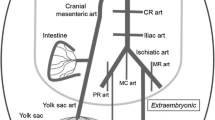Summary
The innervation of blood vessels in the brood patch (thoracic skin) of the domestic fowl was studied by use of the catecholamine fluorescence technique, acetylcholinesterase staining, and the immunoperoxidase technique for demonstration of vasoactive intestinal polypeptide (VIP). Large arteries and veins were sparsely innervated, whereas arteriovenous anastomoses (AVAs) were densely innervated by adrenergic, acetylcholinesterase-positive, and VIP-immunoreactive nerve fibres. The rich supply of different vasomotor nerves to AVAs emphasizes the importance of these vascular shunts in regulating blood flow and, in turn, the transport of heat to the brood patch. Furthermore, the presence of VIP-immunoreactive nerve fibres in the vasculature of the brood patch suggests that VIP might be the mediator of the previously reported cold-induced vasodilatation.
Similar content being viewed by others
References
Bell C, Lang WJ, Laska F (1978) Dopamine-containing axons supplying arterio-venous anastomoses. J Neurochem 31:1329–1333
Böck P (1980) Feinstruktur und Innervation arteriovenöser Anastomosen (AVAs). Wiener Klin Wochenschr 92:179–187
Burnstock G (1972) Purinergic nerves. Pharmacol Rev 24:509–581
Cauna N (1970) The fine structure of the arteriovenous anastomosis and its nerve supply in the human respiratory mucosa. Anat Rec 168:9–22
Clara M (1956) Die arterio-venösen Anastomosen. Anatomie, Biologie, Pathologie. Springer, Wien
Drent R (1975) Incubation. In: Farner DS, King JR (eds) Avian Biology. Academic Press, New York, Vol 5, pp 333–420
Eränkö O, Rechardt L, Eränkö L, Cunningham A (1970) Light and electron microscopic histochemical observations on cholinesterase-containing sympathetic nerve fibres in the pineal body of the rat. Histochem J 2:479–489
Fahrenkrug J, Haglund U, Jodal M, Lundgren O, Olbe L, Schaffalitzky de Muckadell OB (1978) Nervous release of vasoactive intestinal polypeptide in the gastrointestinal tract of cats: possible physiological implications. J Physiol 284:291–305
Grant RT (1930) Observations on direct communications between arteries and veins in the rabbit's ear. Heart 15:281–303
Hales JRS (1985) Skin arteriovenous anastomoses, their control and role in thermoregulation. In: Johansen K, Burggren W (eds) Cardiovascular shunts. Munksgaard, Copenhagen, pp 433–448
Hales JRS, Foldes A, Fawcett AA, King RB (1982) The role of adrenergic mechanisms in thermoregulatory control of blood flow through capillaries and arteriovenous anastomoses in sheep hind limb. Pflügers Arch 395:93–98
Hellstrand P, Fahrenkrug J, Uddman R, Järhult J (1985) Role of vasoactive intestinal polypeptide (VIP) in the neurogenic vasodilatation of the portal vein in the rabbit. Regul Pept 12:309–316
Hillman PE, Scott NR, van Tienhoven A (1982) Vasomotion in chicken foot: dual innervation of arteriovenous anastomoses. Am J Physiol 242:R582-R590
Hökfelt T, Johansson O, Ljungdahl Å, Lundberg JM, Schultzberg M (1980) Peptidergic neurones. Nature 284:515–521
Johansen K, Millard RW (1974) Cold-induced neurogenic vasodilatation in skin of the Giant fulmar Macronectes giganteus. Am J Physiol 227:1232–1235
Korf H-W, Fahrenkrug J (1984) Ependymal and neuronal specializations in the lateral ventricle of the Pekin duck, Anas platyrhynchos. Cell Tissue Res 236:217–227
Larsson L-I (1977) Ultrastructural localization of a new neuronal peptide (VIP). Histochemistry 54:173–176
Lundberg JM, Hökfelt T, Schultzberg M, Uvnäs-Wallensten K, Köhler C, Said SI (1979) Occurrence of vasoactive intestinal polypeptide (VIP)-like immunoreactivity in certain cholinergic neurons of the cat: Evidence from combined immunohistochemistry and acetylcholinesterase staining. Neuroscience 4:1539–1559
Lundberg JM, Änggård A, Fahrenkrug J (1982) VIP as a mediator of hexamethonium-sensitive, atropine-resistant vasodilation in the cat tongue. Acta Physiol Scand 116:387–392
McGregor DD (1979) Noncholinergic vasodilator innervation in the feet of ducks and chickens. Am J Physiol 237:H112-H117
Midtgård U (1985) Arteriovenous anastomoses in the incubation patch of herring gulls. Condor 87:549–551
Midtgård U (1986) The peripheral circulatory system in birds: A morphological and physiological study of some adaptations to temperature regulation. University of Copenhagen, Copenhagen
Midtgård U, Sejrsen P, Johansen K (1985) Blood flow in the brood patch of bantam hens: Evidence of cold vasodilatation. J Comp Physiol B 155:703–709
Molyneux GS, Harmon B (1982) Innervation of arteriovenous anastomoses in the web of the foot of the domestic duck, Anas platyrhynchos. Structural evidence for the presence of non-adrenergic non-cholinergic nerves. J Anat 135:119–128
Molyneux GS, Harmon BV (1983) Substance P nerves in the tongue of the sheep. J Anat 136:662
Murrish DE, Guard CL (1977) Cardiovascular adaptations of the Giant petrel, Macronectes giganteus, to the antarctic environment. In: Llano GA (ed) Adaptations within antarctic ecosystems. Smithsonian Inst, Washington DC, pp 511–530
Sherman JL (1963) Normal arteriovenous anastomoses. Medicine 42:247–267
Silver A (1974) The biology of cholinesterases. Frontiers of biology, Vol 36. North-Holland Publishing Company, Amsterdam
Stefanini M, de Martino C, Zamboni C (1967) Fixation of ejaculated spermatozoa for electron microscopy. Nature 216:173–174
Sternberger LA (1979) Immunocytochemistry, 2nd ed. John Wiley and Sons, New York
Torre de la JC, Surgeon JW (1976) A methodological approach to rapid and sensitive monoamine histofluorescence using a modified glyoxylic acid technique: The SPG method. Histochemistry 49:81–93
Weihe E, Hartschuh W, Yanaihara N, Reinecke M (1981) VIP-immunoreactive nerve fibers in the skin. Neurosci Lett [Suppl] 7:S266
Wolfenson D (1983) Blood flow through arteriovenous anastomoses and its thermal function in the laying hen. J Physiol 334:395–407
Author information
Authors and Affiliations
Rights and permissions
About this article
Cite this article
Midtgård, U. Innervation of arteriovenous anastomoses in the brood patch of the domestic fowl. Cell Tissue Res. 252, 207–210 (1988). https://doi.org/10.1007/BF00213843
Accepted:
Issue Date:
DOI: https://doi.org/10.1007/BF00213843



